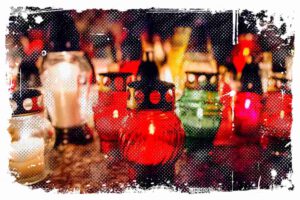Baba Yaga is likely one of the most recognized characters in Slavic mythology. Picture an old woman, living either at the outskirts of a village or alone in the wilderness. She’s a character that often pops up in the legends and tales of our ancestors. Here are few things that we will discuss in this article:
- Baba Yaga and her Role in Ancient Slavic World
- Baba Yaga, Black Cat, Owl and Hut on Chicken Legs
- Baba Yaga as a Witch and Hag in Various Cultures
- Baba Yaga: Strange Legend of an Evil Witch
- Baba Yaga in Pop Culture
- Facts and Trivia about Baba Yaga
Polish Baba Yaga – Role in Ancient Slavic World
Most tales depict Baba Yaga as fundamentally wicked and cunning. However, we’re not completely clear about her original form, thus we don’t fully understand her role in Slavic beliefs.
When it comes to her character, there’s no room for doubt. The very name itself stems from the proto-Slavic word jęga, meaning horror, fear, danger, and also torment and suffering. It is believed that Baba Yaga was initially responsible for taking care of forest animals, hence her place is deep in the forest.
- You will also like this article: Unraveling the Tale of The Wawel Dragon – Krakow’s Emblem
From Forest Caretaker to Malevolent Witch
Researching old tales, scholars of Slavic mythology think that the early form of this forest witch was connected to the world of the dead. Baba Yaga herself was responsible for the mystical rites of passage marking different stages of human life.
↳ PRO TIP: Do you like traveling? Then before you buy any ticket or book an attraction, check if it's available in this worldwide Viator Database. You may save a lot of money and time. No need to thank me :)
Allow me to explain – she always showed up when kids entered adulthood, when mature individuals faced old age, and ultimately when it was time for someone to depart from this world.

I think it is worth to say that the modern-day image of a nightmarish and evil witch is the result of early Christian efforts to demonize female figures from older religions. As we know, the Church wasn’t particularly fond of strong women and assigned them a subordinate role in the new world it conquered. So, if you want to understand Baba Yaga more deeply, being there, you need to know these historical influences.
Baba Yaga – Her Black Cat, Owl, and Peculiar Chicken-Legged Hut
Even though we don’t know much about what Baba Yaga looked like in the ancient, pagan times, we certainly know how she’s depicted in modern-day fairy tales. Picture an old, deformed woman with cold, evil eyes and not much in terms of good looks.
She’s covered with boils and warts, deep wrinkles and numerous scars all over. But the most striking feature is her large, hook-like nose adorned with a revolting pustule. The old hag dresses in dirty rags and wears a pointed hat.
This witch is usually accompanied by a black cat or a raven, sometimes an owl, and of course, spiders, spinning their webs everywhere you look. Her abode is a wonky wooden hut that’s a weird thing itself. Built from rough planks, the hut stands on a forest clearing, balancing on a chicken leg. When the witch enters or leaves, the whole hut crouches down to make it easier for her.
Inside the Odd Hut
From the outside, the witch’s hut looks rather repelling and shabby. Inside it’s not any better and it reportedly smells like a grave. Stuff is strewn everywhere: jars with herbs, poisons, and strange creatures or parts of them submerged in some liquid. Scattered around are makeshift furniture items.

The centerpiece of the only room is a huge cauldron, with a fire constantly crackling underneath. It’s in this pot that all sorts of potions are concocted, aiding the witch in her dark designs.
Baba Yaga – Witch, Sorceress, and Crone in Various Cultures
The word Yaga doesn’t only stir up bad associations among the Slavs. In other languages too, it doesn’t mean anything pleasant. Serbians interpret it as horror and a chill of fear, for the Czechs, it’s a malicious nymph living in forests, and in Sanskrit, it describes a snake.
- You may also like to read: Top 20 Must-Watch Old Polish Cartoons Not Only for Children
Old Russian legends depict Baba Yaga as a monstrous creature devouring people. According to these stories, she particularly relishes children, whose bodies she bakes, boils, and even stuffs. In the end, the bones and whatever is left of the victim are ground in a giant mortar. The resulting powder is used to feed her hut.
Baba Yaga Legends in Other Countries
Legends circulate in the Balkans about Baba Yaga, who occasionally assists people. But before she fulfills someone’s wish, that person must perform a more or less complicated task. Once all the requirements are met, the witch grants the request. However, if the poor soul fails to carry out the orders, they end up in the cauldron, and their bones find their way to the mortar.
Among Lithuanian legends, there’s one where a lost girl in the woods asks Baba Yaga for directions and a safe return home. Interestingly, the evil witch helps the girl and selflesly leads her out of the dark forest. This example shows that the figure of the forest-dwelling witch is not one-dimensional.
Baba Yaga Tale
We must now move forward to the story that’s being whispered in a certain village located on the border between Hungary and Romania. Here, an unusual legend about Baba Yaga took a completely unexpected turn. Instead of being a wicked, repulsive old woman as we’re used to, Baba Yaga was rather young and attractive. Let me take you through it.
In a remote and shadowy forest not too far from a village, lost from popular routes and forgotten by time, lived an extraordinarily beautiful woman. Her name? Long forgotten. Nobody really knew when she appeared or why she chose to live in solitude in her strange hut in the forest clearing.
All they knew was that she was stunningly beautiful, and her activities were cloaked in mystery. Once in a while, she would visit the village either because she needed something or she was needed.
She had an extensive knowledge of herbs and mixtures, the ones that eased illnesses and other discomforts. Folks would whisper, guessing she was a witch practicing magic. But she didn’t bother anyone, and so, the villagers tolerated her existence.
Everything changed when some of the village women started noticing that their men were disappearing for hours into the forest, neglecting their duties.
After a meticulous investigation that involved lurking in the bushes near the forest path leading to the aforementioned clearing, they concluded that the mysterious beauty had bewitched half of the village men.
Not just the young lads, but mature men, and even grandpas, were found to willingy visit her woodland cabin. A drama ensued. Jealous women were about to tear their men apart and, under the threat of cutting off their natural treasures with a sickle, they imposed a ban on entering the forest. However, one woman, the most vindictive, decided not to forgive the forest witch so easily.
For a long time, the area had been terrorized by ravenous wolves, who occasionally managed to catch and kill some of the residents or few travelers daring to venture into the wilderness alone. Over the years, many children had gone missing near the nearby river and in the forest, most likely devoured by these devilish beasts whose howls filled the moonlit nights.
From Ghoulish Ideas to Ghastly Execution
These horrifying events planted a wicked idea in the heart of the aggrieved woman. She thought of exhuming the old bones from the nearby cemetery and planting them in the home of the detestable witch.
Then, she would just spread rumors, and eventually, someone would have to go to the forest and find evidence that not all crimes can be attributed to the foolish, wild wolves.
She believed her idea was quite convincing, so she decided to put her plan into action. One night, she sneaked into the cemetery, dug up an old grave belonging to a forgotten child, and excavated the bones.
After the sun went down, our brave lady made her way to the forest, guided by the light of a full moon that looked as big as a plate. Upon reaching the clearing, she spotted the witch departing from her hut, basket in hand, heading deeper into the woods.
„Off to gather those foul, devilish herbs,” she thought to herself.
A wicked grin spread across her face as she approached the hut, comforted by the surrounding silence and the shadow that hid her from sight.
Stealthily, she opened the door and crawled in, dragging behind her a sack filled with bones that clinked against each other. A fire in the center of the room illuminated the interior, allowing her to quickly assess the surroundings.
She saw a small door in the corner, presumably leading to a basement. Thinking it the perfect place to plant the incriminating evidence, she let out a silent, malicious chuckle.
To her surprise, upon opening the hatch, she saw a small fire burning in the basement too. Instead of simply tossing in the sack of bones, curiosity led her down into the basement.
She was rooted to the spot at what she saw. The floor was scattered with human bones, and a pot filled with a thick, bubbling soup sat on a small stove. A human leg protruded from the pot, and what appeared to be human eyes floated on the surface of the soup.
A Horrifying Twist in the Tale
The startled woman felt a presence behind her—it was the witch, who had returned from her forest expedition. She no longer looked like the forest beauty that stirred envy among the village women.
She was hunched over, wrinkled, and gaunt, looking like skin stretched over a skeleton. The beautiful, airy dress that barely covered the seductive body of the forest nymph was replaced by horrible, stinking rags.
The terrified woman’s last audible memory was a harsh, grave-like voice saying,
Had I known you’d visit, I would’ve gathered more wild garlic.
After that, the woman was never seen again. The witch and her hut vanished, leaving no trace on the forest meadow, as if they had never existed. The people didn’t know how to explain it and just shook their heads as time passed.
Eventually, someone noticed, with astonishment, that the wolves had stoped attacking people, and no one had been killed for a long time.
Baba Yaga in Polish Pop Culture And Beyond
Baba Yaga has a way of showing up everywhere, from books to video games. If you enjoy stories, you’ll find her sprinkled in many famous tales.
- „Hansel and Gretel” – We all know this tale with two kids in the lead roles. They get lured to Baba Yaga’s house by the sweet smell of cookies and candy. The kids pull off some clever tricks and manage to escape. The story has seen many screen adaptations.
- „Vasilisa the Brave and Baba Yaga” – This Russian fairy tale shows Baba Yaga as a wise, cruel, but fair goddess. You can find a more detailed version of this old Russian tale in the book Running with the Wolves.
- „Enchantment” – This novel by Orson Scott Card unfolds in communist Russia and Ukraine and features a beautiful sleeping woman and a brave Jewish man named Ivan Smiecki.
- Baba Yaga also pops up in Hellboy comics and movies.
- She even features as an Eastern demon in the movie Don’t Knock Twice.
- „The Cuckoo and the Crow” – This book by Magdalena Wolff talks about Baba Yaga.
- „Deathless” – This novel by Catherynne M. Valente presents a witch as terrifying as she is interesting.
- „Hansel and Gretel” – Witold Jabłoński’s book tells the story of the Slavs and has an interesting mention of Baba Yaga.
- She also appears in the Witcher books and series.
- In the John Wick movie series, the main character has the nickname Baba Yaga because he, like the Slavic witch, inspires fear and brings death.
- „Baba Yaga’s Assistant” – This comic is about Baba Yaga who is forced to look for an assistant.
- Baba Yaga also shows up in video games like Tomb Raider and Smite.
Interesting Facts About Baba Yaga
- Baba Yaga is a well-known figure in Slavic beliefs.
- In legends and fairy tales, Baba Yaga appears as an old and repulsive witch.
- Only a person with a pure heart could triumph over Baba Yaga in the fairy tales.
- The word Yaga in Proto-Slavic language signifies torment, horror, and danger.
- Baba Yaga has various roles in different cultures. She appears as a witch, goddess, or demon.
- Baba Yaga initially had connections with the world of the dead.
- Baba Yaga lived in a hut on chicken legs, with a fence made of human bones and skulls.
- Baba Yaga moved around on a broomstick, her main mode of transport. In some tales, the witch also flew in her cauldron or a large mortar.
- The character of Baba Yaga also appears in music. I recommend the symphonic poem – Baba Yaga, created by Russian composer Anatoly Lyadov in 1904.
- Although Baba Yaga is described as a witch, cannibal, and pure evil in many tales, there are stories that tell about the witch’s ability to help people.
- Many researchers believe that Baba Yaga fell victim to the fight against the matriarchal religious system of ancient Slavs. To vilify the female character in mythology, a horrid and thoroughly evil Baba Yaga was created. Simultaneously, the witch became a symbol of feminism and resistance against the imposed male dominance in the modern world.
- If you’re eager to know more about creatures from Slavic mythology that still frighten us today, you’ll find more in our section on monsters.
References:
- https://pl.wikipedia.org/wiki/Baba_Jaga
- https://historiamniejznanaizapomniana.wordpress.com/2015/04/27/baba-jaga-historia-prawdziwa/
- https://gazetaolsztynska.pl/713108,Baba-Jaga-tajemnicza-postac-ze-slowianskiego-folkloru.html




